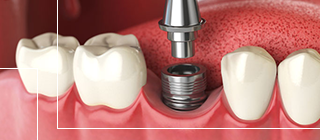Dental Implant Treatment
What are dental implants?
A natural tooth consists of a crown (the part you see above the gum), and the root (the part hidden under the gum, within the jawbone).When a person is missing a tooth, the dentist must decide how to re-create the crown portion, and he must choose the best method to hold it in place. Hence, dental implants were created for this purpose. Dental implants are metallic cylinders that are placed into the jawbone where original teeth once existed. These root-like cylinders are used to secure a replacement tooth in place in a spot where a tooth is missing.

How do implant dentistry work and what is the purpose of it?
Dental implants replace the form and function of missing teeth. Various replacement options are possible:-
- Dental implants can be used to replace a single tooth, so that grinding down or altering adjacent teeth is no longer necessary.
- Dental implants can be used as anchors to support a fixed bridge.
- Dental implants can support loose teeth by being splinted to them.
- Dental implants can support replacement teeth for an entirely toothless jaw.
- Dental implants can provide stability for a complete denture, thereby eliminating unsightly moving and clicking associated with dentures.
Dental Implant treatment may can divided into 2 stages:
1. First stage implant post placement: placement of the titanium dental implant post
2. Second stage fixed prosthetic on implant: making the crown, bridge or over dentures (i.e. the false teeth) with the abutment to be fitted over the dental implant post
FAQ about Oral Implantology
It is an advanced medical technology for the treatment of tooth loss. A titanium implant is implanted in the toothless area of the jawbone. The jawbone fuses with the titanium surface providing a strong anchorage for the implant. The implant function as a support for the dental prosthesis constructed over it.
- It can treat cases untreatable with conventional methods of dental bridges and dentures.
- It prevents further resorption of the jawbone following tooth loss.
- It can perfectly restore chewing function.
- It avoids cutting down and overloading the natural teeth occurring with conventional mean of replacing tooth loss.
- It helps restore a patient’s self-esteem and confidence since it gives the feeling of regaining the real teeth.
- It functions better than conventional dental bridges and dentures.
- It gives superior aesthetic results.
You will be a suitable candidate for oral implant if you fulfill the following requirements:
- You must be medically fit to undergo ordinary surgery.
- Your jaw must have enough bone to support the implant (if not, bone grafting may be required).
- There must be enough space to accommodate the prosthesis over the implant.
- You must understand what the treatment can offer.
- You must realize to what extent the treatment can meet your expectations.
You should consider implant when:
- You do not want to have your natural teeth cut down which is required in making conventional dental bridge.
- You cannot wear or chew well with your denture.
- You cannot tolerate a denture in your mouth.
- You do not want to damage your remaining teeth from wearing a partial denture.
- You have lost your back teeth making it impossible to construct a conventional dental bridge.
- You have a long toothless span which is not indicated for making a conventional ndental bridge.
- You want superior aesthetic results with your tooth replacement.
- You want the most effective way of restoring your chewing function.
Whether for a single missing tooth or replacement of all of a patient’s teeth, oral implant is now recognized as standard treatment for a full range of problems. If you want to know more about oral implant, please consult your dentist.
The surgery can only commence after thorough diagnosis and treatment planning. A recipient site of the same size and shape as the implant is created in the jawbone with drilling instruments. The implant is inserted into the site prepared. Usually, a healing period of 3 to 6 months is required for the jawbone to fuse with the implant. The jawbone has different densities in different areas – the denser the bone, the shorter the healing period. After this healing period, the prosthesis is constructed over the implant and the treatment is completed. Usually, a straightforward implant treatment takes about 4 to 7 months to complete. Longer periods are required for complex situation such as cases requiring bone grafting.
The operation will be performed under aseptic condition usually in a clinic with proper facilities and condition for oral implant surgery. Local anaesthesia is given for pain ncontrol during the operation. Intravenous sedation can be given if necessary. Pain which may occur after the operation can effectively be controlled with oral medications. The prosthetic part of the implant treatment does not require anaesthesia.
Modern oral implant treatment is highly successful, as a general guideline, the five-year success rate of oral implant over 95% with the lower jaw (mandible) and about 90% with the upper jaw (maxilla). The success rates may slowly decrease as the implant stays longer in functio n. In difficult cases, the success rates are expected to be lower. Despite the overall high success rates with oral implant treatment, there is still the possibility of failure which can be contributed by various factors and conditions, such as poor healing power, poor bone quality, smoking and diabetes.
The service life of an oral implant can be affected by many factors: high standards of treatment, meticulous daily cleaning by the patient, regular professional maintenance, abstinence from smoking and avoidance of overloading (like chewing bones, shells, hard nuts and candies), can contribute to the durability of the oral implant. In view of the high success of modern oral implant treatment, an oral implant can be considered a long lasting medical implant that does not need to be changed.
Whereas no medical treatment can be guaranteed 100 percent without risks and failures, implant operation can be considered very safe. The prosthetic phase of treatment is basically non- invasive and non-surgical in nature.






